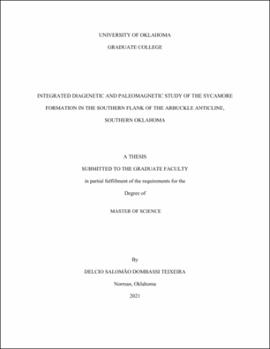| dc.description.abstract | This study aimed to evaluate the paragenesis of the Mississippian Sycamore Formation in the southern Flank of the Arbuckle Anticline in order to document the extent of diagenetic alteration in outcrop, assess the factors controlling the diagenesis (open vs. closed), and determine the timing of diagenetic events. Core plugs were collected from multiple sites in the southern flank of the Arbuckle Anticline (I-35 outcrop) for thin sections as well as for anisotropy of magnetic susceptibility (AMS) and paleomagnetic analysis. Thin section and scanning electron microscope (SEM) analysis were used to identify the microfacies, diagenetic features, pore types, fracture mineralization, and the parageneses based on cross cutting and textural relationships. The AMS analysis was performed to obtain information about the fabric of the rock and level of alteration. Paleomagnetic analysis was used to identify the magnetic components and date any chemical remanent magnetizations (CRMs). The results of this study contribute to the understanding of micro-textural fabric alteration and add insights into the complexities related to pore evolution of the Mississippian strata.
The Sycamore Formation is characterized by five microfacies- argillaceous mudrock, siliceous mudrock, calcareous mudrock, calcitic siltstone, and calcite cemented siltstone. Major diagenetic events include calcite cement precipitation, feldspar dissolution, clay alteration, styliolitization, and fracturing. Early calcite cement occludes most of the porosity in calcite cemented siltstones, and feldspar dissolution is more predominant in calcitic siltstones. Inverse AMS fabrics are concordant with precipitation of ferroan dolomite as a result of alteration by iron-rich dolomitizing fluids. A secondary magnetization, interpreted to reside in magnetite, is present in the Sycamore Formation and the upper Woodford Shale, but determining the timing of remagnetization was not possible because a fold test could not be performed. The Sycamore Formation is interpreted to have been a closed diagenetic system with internal fluids derived from the mudrock facies. During burial, the Sycamore Formation might have evolved into an open system with the introduction of external iron-rich dolomitizing fluids and acidic fluids from organic matter maturation of the underlying Woodford Shale. Petrographic analysis suggests that there is no sufficient evidence for hydrothermal alteration in the Sycamore Formation. | en_US |
